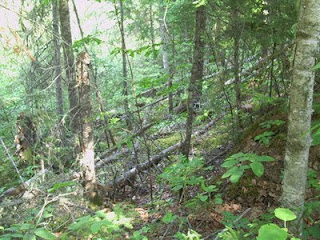Spearheaded by Sierra Legal, the groups firing these WORDS are: Nature Canada, Sierra Club of Canada, Wildlands League, Canadian Parks and Wilderness Society (CPAWS), Sierra Club (U.S.). Great Lakes United, Earthroots, and Ontario Nature.
On July 17, 2001, one person thought something was going to happen in a certain place in Ontario so a complaint was sent to the Canadian Wildlife Service (CWS). His complaint was: logging was going to take place and bird nests were going to be destroyed. In August 2001, the complaint was investigated by the CWS and nothing was found to substantiate the complaint. Later, somehow, nine environmental groups became privy to the complaint. These groups made up a number, (i.e. a hypothetical scenario). They multiplied the discontinued breeding bird density per hectare by the number of hectares clear-cut and multiplied that by a factor of 0.0536, to account for seasonal variation in logging rate, and a nesting period of one month and came up with a total of 43,700 destroyed migratory bird nests and Sierra Legal submitted their complaint on February 6, 2002, to the Secretariat.
This hype was pressed forward in 2004 and 2005 until North American Free Trade Agreement's environmental watchdog, the Commission for Environmental Cooperation was involved and they ordered the Secretariat to prepare a factual record.
In early January, 2007, the headlines were screaming: " 45,000 Migratory Bird Nests Destroyed By Clear-cut Logging In Ontario In 2011" Another report claimed, "85,000 Migratory Bird Nests Destroyed By Clear-cut Logging In Ontario in 2001". One Toronto paper blared, "Ontario Government Coddling Killers".
February 5, 2007, the Secretariat of the Commission for Environmental Cooperation of North America released a 272 page Ontario Logging Factual Record, completed in 2006. This factual record more or less had to be done because all 49 operating Forest Management Units in the Province of Ontario were being named by these environmental groups as alleged destroyers of 45,000 migratory bird nests in nesting season 2001, thus contravening Section 6a of the Migratory Birds Regulation adopted under the Migratory Birds Convention Act of 1994, (",,,an offence to disturb, destroy or take a nest, egg, nest shelter, eider duck shelter or duck box of a migratory bird without a permit,") Canada is being seen as failing to enforce said Regulation. All this was done without one migratory bird's nest being seen destroyed by loggers or found destroyed by loggers in 2001.
Our Assistant Deputy Minister, International Affairs, did submit a letter that commented on the general tone of the document (Ontario Logging Factual Record), that it was not well balanced and did not present a "fulsome accounting of the facts."
Fact One: "In 2001 logging in Ontario occurred on less than 0.5% of land base, therefore, by inference, 99.5% of migratory bird nests remained on the landscape, subject to natural predation and disturbances."
Fact Two: "More than twice the area logged is burned or affected by insect damage in a year: each of these natural disturbances results in the destruction of nests;" and
Fact Three: "Natural disturbances alone would deplete more area than harvested annually if fire suppression were not undertaken in conjunction with harvesting."
For those of you who are wondering how insects can lead to the destruction of migratory bird nests, let us just look back a couple years when we were slithering around on the Forest Tent Caterpillars. In the third year of the infestation every leaf was gone from every shrub and deciduous tree. One American Redstart was observed sitting in her nest in a now-bare willow. Caterpillars were crawling along the nest edge. The next day it was only an empty nest. The eggs were gone. This nest, which is usually secluded, was in open view for predation by other birds so inclined.
Quick, should we put some numbers on this event? The caterpillars were invading from Thunder Bay to Nipigon. Say they spread out 5 km both sides of the highway 11/17. That's 10 times 109 (109km being the distance from Thunder Bay to Nipigon). That's 1,090 square kilometres of Killer Caterpillars!
Should we be surprised by this flight of imagination? Not if we pay our hydro bill in Ontario, because every month we pay for electricity that never reaches our home, it is lost in transmission.







